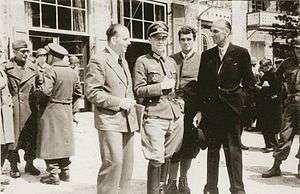Bogislaw von Bonin

Bogislaw Oskar Adolf Fürchtegott von Bonin (January 17, 1908, Potsdam – August 13, 1980, Lehrte near Hannover) was a German Wehrmacht officer and journalist.
Early life
Bonin was born in Potsdam, Brandenburg, and joined the 4. Reiterregiment (4th Cavalry Regiment) of the German Reichswehr in 1926. From October 1927 to August 1928, he received officer training at the School of Infantry, Dresden, together with Claus von Stauffenberg and Manfred von Brauchitsch,[1] and was promoted to Lieutenant in 1930. In 1937-1938, he attended the War Academy (Kriegsakademie) in Berlin and became a member of the Army High Command in 1938.
World War II
In 1943, he was the chief of staff of the XIV Panzer Corps in Sicily and for a short time Chief of Staff of the LVI Panzer Corps of the 1st Hungarian Army in 1944. He attained the rank of Colonel and became the Chief of the Operational Branch of the Army General Staff (Generalstab des Heeres).
Arrest
On 16 January 1945, Bonin gave Heeresgruppe A permission to retreat from Warsaw during the Soviet Vistula-Oder Offensive, rejecting a direct command from Adolf Hitler for them to hold fast. He was arrested by the Gestapo on 19 January 1945 and imprisoned first at Flossenbürg concentration camp and then Dachau concentration camp.
With several family members (Sippenhäftlingen) of the July 20 plot and other notable prisoners such as Léon Blum, Kurt Schuschnigg, Hjalmar Schacht, Franz Halder and Fritz Thyssen, he was transferred to the Tyrol but the transfer ended up delivering them to Niederdorf (Villabassa) in the South Tyrol.
On 30 April 1945, he managed to contact senior Wehrmacht officers who dispatched an overwhelming force of regular German troops to intimidate the SS guards into abandoning their position and leaving the prisoners behind.[2] The Wehrmacht freed the prisoners and then assisted them in being accommodated at the Pragser Wildsee Hotel south of Niederdorf until US troops marched into Niederdorf on 4 May 1945 [3]
Post World War II
Bonin became a prisoner of war and started working as a freight forwarder in 1947, but later on for Daimler Benz. In 1952, he joined the "Amt Blank" (Bureau Blank, named after its director Theodor Blank), the predecessor of the later Federal Ministry of Defence, as the head of the subdivision "military planning", to map out a strategy for the German contribution to the European Defence Community. However, he came into conflict with the Adenauer government, as he favoured a more neutral or independent German policy. In 1955, before the German Bundeswehr was established, Bonin was released and became a journalist.
Bonin died in Lehrte.
Awards
- German Cross in Gold on 14 January 1942 as Major im Generalstab in the 17. Panzer-Division[4]
References
- ↑ Peter Hoffmann: "Claus Schenk Graf von Stauffenberg", München 2007, ISBN 978-3-570-55046-5
- ↑ Pragser Wildsee.com
- ↑ Hans-Günter Richardi, SS-Geiseln in der Alpenfestung http://www.raetia.com/index.php?id=338%5Bpermanent+dead+link%5D
- ↑ Patzwall & Scherzer 2001, p. 51.
- Olaf Theiler: Abschreckung oder Verteidigung.. Das Sicherheitsdilemma der Bundesrepublik. - Gescheiterter Außenseiter – Der Rebell Bogislaw von Bonin, in: Informationen für die Truppe – Zeitschrift für Innere Führung (der Bundeswehr)
- Denkschrift Bogislaw von Bonin: Wiedervereinigung und Wiederbewaffnung – kein Gegensatz (February 1955) Reaction of Blank (March 1955)
- Heinz Brill, Bogislaw von Bonin im Spannungsfeld zwischen Wiederbewaffnung – Westintegration – Wiedervereinigung. Ein Beitrag zur Entstehungsgeschichte der Bundeswehr 1952-1955, Band I. Baden-Baden 1987, Band II. Baden-Baden 1989
- Patzwall, Klaus D.; Scherzer, Veit (2001). Das Deutsche Kreuz 1941 – 1945 Geschichte und Inhaber Band II [The German Cross 1941 – 1945 History and Recipients Volume 2] (in German). Norderstedt, Germany: Verlag Klaus D. Patzwall. ISBN 978-3-931533-45-8.